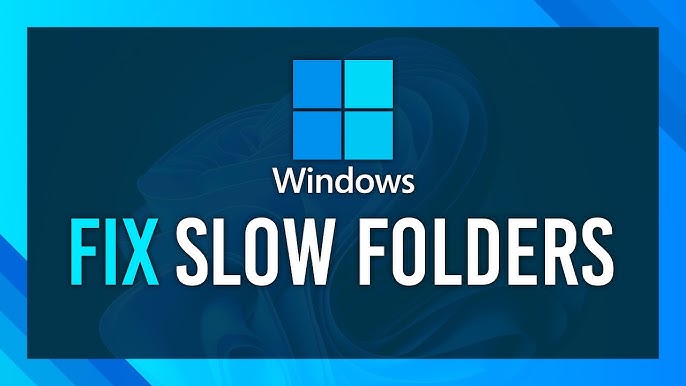Unleashing Speed: A Comprehensive Guide to Fixing Slow-Opening Windows Downloads Folders in Windows 10

Introduction
In the bustling digital landscape, where efficiency and speed are paramount, a slow-opening Downloads folder can be a frustrating bottleneck. Windows 10, renowned for its versatility, often encounters issues that affect the responsiveness of essential folders. This comprehensive guide aims to unravel the intricacies of addressing slow-opening Downloads folders in Windows 10, empowering users to reclaim a seamless and efficient file management experience. Whether you’re a professional navigating a multitude of downloads or a casual user seeking a smoother workflow, this guide provides step-by-step solutions, insights, and optimization techniques to elevate your digital experience.
Understanding the Causes of Slow-Opening Downloads Folders
1. Accumulated Files and Subfolders:
- Over time, the Downloads folder may accumulate a significant number of files and subfolders, leading to increased load times.
2. Background Processes and Indexing:
- Windows engages in background processes, such as indexing, to enhance search functionality. If these processes are impeded, they can contribute to delays in folder access.
3. Disk Fragmentation:
- Fragmentation occurs when files are scattered across different physical locations on a disk. This can hinder the swift retrieval of data and impact the opening speed of folders.
4. Corrupted Thumbnails and Cache:
- Thumbnails and cache files associated with files in the Downloads folder can become corrupted, causing delays in rendering previews and icons.
5. Third-Party Software Interference:
- Installed third-party software, especially antivirus programs and optimization tools, might interfere with the normal functioning of file access, leading to delays.
Step-by-Step Solutions to Improve Downloads Folder Opening Speed
1. Organize and Clean Up Downloads:
- Begin by organizing and cleaning up the Downloads folder. Delete unnecessary files, move important files to relevant directories, and consider archiving or deleting large files that are no longer needed.
2. Optimize Background Processes:
- Optimize background processes and indexing to improve folder access speed.
- Open the “Settings” app (
Windows + I). - Go to “System” and select “About.”
- Click on “Advanced system settings” on the right.
- Under the “Advanced” tab, click on “Settings” under the “Performance” section.
- Choose “Adjust for best performance” or manually select options that prioritize performance over visual effects.
- Open the “Settings” app (
3. Defragment the Disk:
- Regularly defragment your disk to optimize file placement and enhance data retrieval speed.
- Type “Defragment and Optimize Drives” in the Start menu search and open the corresponding tool.
- Select the drive containing the Downloads folder and click “Optimize.”
4. Clear Thumbnails and Cache:
- Clearing corrupted thumbnails and cache files can improve the rendering speed of icons and previews.
- Open the “Disk Cleanup” tool by searching for it in the Start menu.
- Select the drive containing the Downloads folder and check the box for “Thumbnails.”
- Click “OK” to clear the selected items.
5. Check for Disk Errors:
- Detect and fix disk errors that might contribute to slow folder access.
- Open Command Prompt as an administrator by right-clicking the Start button and selecting “Command Prompt (Admin).”
- Type
chkdsk /fand press Enter. - Follow the on-screen instructions and restart your computer.
6. Disable Unnecessary Startup Programs:
- Minimize the number of programs launching at startup to allocate system resources efficiently.
- Right-click on the taskbar and select “Task Manager.”
- Navigate to the “Startup” tab and disable unnecessary programs.
7. Exclude Downloads Folder from Antivirus Scans:
- Exclude the Downloads folder from real-time antivirus scans to prevent unnecessary delays.
- Open your antivirus software and locate the settings or exclusions section.
- Add the Downloads folder to the list of excluded directories.
8. Update Device Drivers:
- Outdated or incompatible device drivers can contribute to performance issues.
- Open the “Device Manager” by searching for it in the Start menu.
- Right-click on each device and select “Update driver.”
9. Increase Virtual Memory:
- Adjusting virtual memory settings can enhance system performance.
- Open the “System Properties” window by searching for it in the Start menu.
- Navigate to the “Advanced” tab and click on “Settings” under the “Performance” section.
- Go to the “Advanced” tab and click on “Change” under the “Virtual memory” section.
- Uncheck “Automatically manage paging file size for all drives” and set a custom size.
10. Consider a Folder Optimization Tool:
cssCopy code
- Explore third-party optimization tools that specialize in enhancing file and folder access speed. Exercise caution and choose reputable tools to avoid potential risks.
Best Practices for Maintaining Optimal Folder Performance
1. Regularly Clean and Organize:
- Adopt a habit of regularly cleaning and organizing your Downloads folder. Remove unnecessary files, categorize downloads, and archive or delete large files to prevent clutter.
2. Backup Important Files:
- Before performing any optimizations, ensure that important files are backed up. This precaution safeguards against accidental data loss.
3. Monitor System Resources:
- Keep an eye on system resources using the Task Manager. Identify resource-intensive processes and address them to maintain a responsive system.
4. Update Windows:
- Ensure that your operating system is up to date by installing the latest Windows updates. Updates often include performance improvements and bug fixes.
5. Use Reliable Security Software:
- Employ reputable antivirus and security software to ensure the safety of your system. Regularly update the security software and perform full system scans.
6. Be Mindful of Installed Programs:
- Be selective about the programs you install on your system. Avoid unnecessary third-party optimization tools that may cause more harm than good.
7. Opt for SSD Storage:
- If possible, consider upgrading to Solid State Drive (SSD) storage. SSDs offer faster read and write speeds compared to traditional Hard Disk Drives (HDDs).
Conclusion
A slow-opening Downloads folder in Windows 10 is a roadblock that can hinder productivity and user experience. This comprehensive guide, enriched with step-by-step solutions, optimization techniques, and best practices, empowers users to reclaim the speed and efficiency of their file management system. By understanding the underlying causes and implementing strategic measures, users can transform their Downloads folder into a swift and responsive gateway to their digital content. As you embark on the journey to optimize your system, let the tips and insights within this guide be your compass, guiding you towards a seamless and efficient Windows 10 experience.







